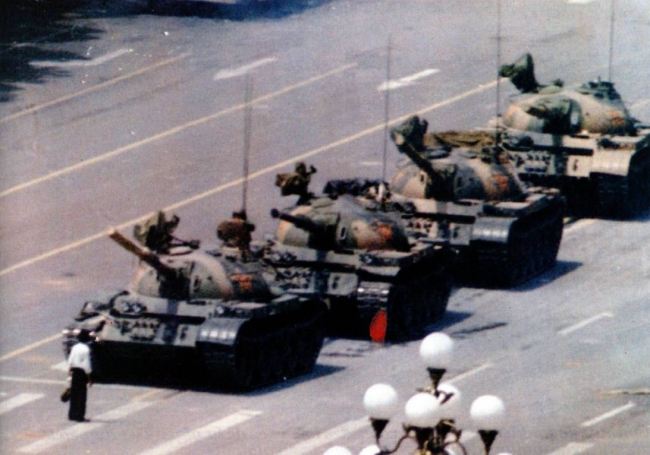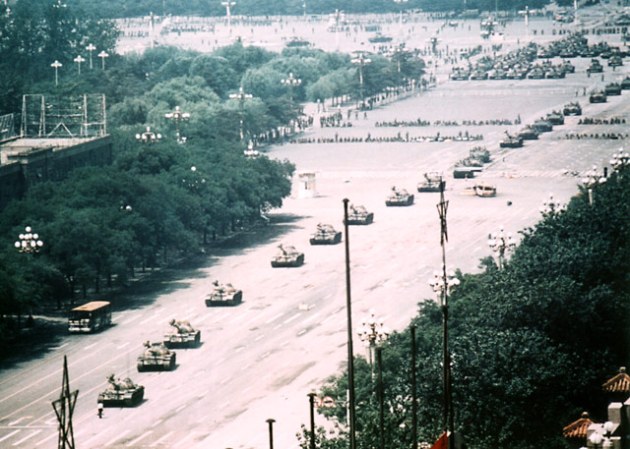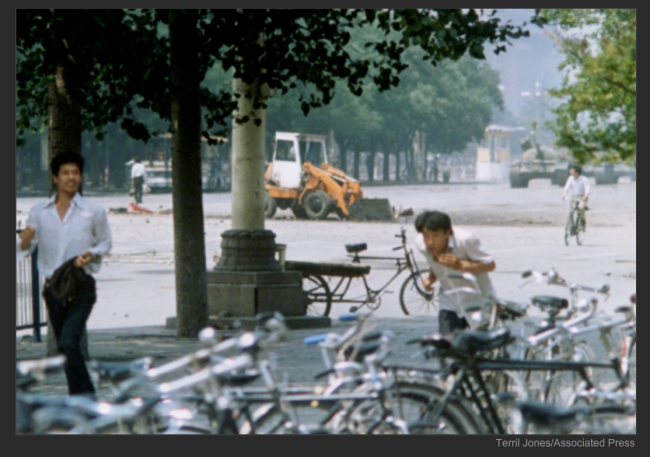NOTE: This post has been edited and a newer/improved version is here.
Also known as the “Unknown Rebel,” Tank Man is the unknown protagonist of a stand off with a column of Type 59 Chinese tanks. His stance, encapsulated in time on Beijing’s Changan Avenue, is determined. He is slight, wiry in the tradition of a wushu hero perhaps, but his great strength isn’t physical. We know so little about him. Any name we give him is hotly disputed. None of the surviving images even capture his face. We are left with the set of his shoulders and his angry strides as he climbs up that first tank, demanding to speak to the officer inside.
I’m getting ahead of myself. It’s important we imagine Tank Man complexly, or as well as we are able to with so little information about who he was and where he lives (or lived) out the rest of his days. Most people know him as a moment in time. The most widely circulated image of Tank Man comes to us from the AP’s Jeff Widener. It’s the one at the head of this post. It’s the one that accompanies all of these front page stories, once it was smuggled out of China by a young tourist. Shot from the balcony of the Beijing Hotel, it shows us an succinct portrait of what is essentially a civilian man (benign to the point of absurdity: he seems to still be carrying his shopping) standing against the state machine, here represented by four tanks. Outside the action, artifacts from reality remains: a cluster of lamps in the lower frame. That mundane street lamp gives this image a greater context. This is not a warzone; it’s a street in the very heart of Beijing.
Those unlit lamps draw us back into the day. While the nights of June 3rd through 4th were a burning hell of smoke and terror, June 5th experienced most of the bald-faced, daylight violence. Near the Beijing Hotel, security forces were shooting anyone who approached the Square—including people running away, doctors, nurses, and rescuers. No one could even come collect the dead. Those unlit street lamps remind us that we’re in a city, but not even just a city: Beijing has been the capital of China for hundreds of years. As journalist Jan Wong puts it, not even Mao had ever dared bring the military into Beijing. But the China’s then-leaders didn’t just mobilize local troops, they brought in soldiers from all over the nation—as far as Guangzhou province. Soldiers were using battlefield-grade weapons on unarmed civilians. Those Type 59 tanks the Unknown Rebel is facing off against remained the backbone of the Chinese army for over another decade. The situation is ludicrous. Dystopic. A precedent that can be repeated.
Want more context? Here’s the rest of that tank column.
Wow. I can’t attribute this photo because I haven’t been able to find credits anywhere, but while it may seem obvious that a column of tanks would be much longer than four, seeing it laid out for you is quite different. What strikes me is how easy it is to throw a cog into such a large machine. Because really, you don’t have to stop all of those tanks individually: you only have to stop the tank in front. How do you stop the tank in front? You stop its commander.
Have some raw footage of his interaction with that front tank. Unfortunately, the nat sound seems to have been lost.
Tank Man seems to taunt the authority of the state. While the commander of the tank tries to go around him, he steps in front of it again and again before finally climbing onto the tank itself. He actually bangs on the hatch of that commanding tank and converses angrily with its occupants: probably its commander and its gunner. In the end, he’s led away by a cluster of men, dissolving back into the crowd. Let’s remember that Tank Man isn’t just a lone rebel for a moment. He converses with soldiers that blazed their way to Tiananmen the night before, part of a group even responsible for shooting people inside their apartments—their kitchens—with battlefield grade weapons. Tank Man’s story is an interaction, and one we view from the outside. A conversation we can’t even eavesdrop in on because their voices have been lost to time.
Why did that leading tank stop? There are reports of disobedience in the military. One general lost his command and was subsequently jailed because he refused to carry out the violence the night of June 3rd without receiving written orders. (Only verbal orders were given that night, because, again paraphrasing Jan Wong, Chinese people have this thing about history: while whoever’s in charge tends to write the rules now, the next dynasty never forgets.) But literally on the other side of the Square civilians are getting mowed down, so why is this one guy such a big deal?
There are competing theories here. There were, like that aforementioned general, acts of defiance. Soldiers who later claimed they fired into the air rather than at civilians. There’s a theory, given to The Epochtimes by Chinese dissident Wei Jingsheng, that the commander of the tank column had been classmates with Tank Man. This seems like pure speculation, but the narrative power of this story is admittedly romantic. The Fox and the Hound recast in modern China. Two boys grow up together in the hardships of China during the Cultural Revolution and later end up on separate life paths. One becomes a military officer, the other is settled in Beijing. Both experience the most horrific nights of their lives and only one of them is trained to deal with it. Then, they are again thrown together under adverse circumstances at the Gate of Heavenly Peace. The telescopic lenses of the world are watching. There isn’t a dry eye in the audience.
It’s a cinematic narrative, and, like in all things of such a nature, we want the Hollywood ending. But there is none. A group of men talk to our Unknown Rebel before he gets hustled off by a few of them. Are they security forces? Do they mean him well? Again, no one knows. Some like to believe that they were benevolent bystanders, and that somewhere now Tank Man is going about his daily life: anonymous, still in China. Wei’s narrative ends rather badly. He says the gentlemen who hustled our hero away were in fact plain clothes security officers, but, under orders from the tank commander, they were in fact trying to keep Tank Man safe. Unfortunately, they lost track of him and he rushed in front of another column of tanks, the commander of which our hero hadn’t been schoolboys with. He was crushed to death, out of sight of the world’s media.
The veracity of either ending (the anti-climactic or the maudlin) cannot be confirmed at this time, if ever. So let’s end the series with a prequel instead. In 2009 Terril Jones of the Associated Press shared a gem of a photograph with the New York Times. It offers new angle on the Tank Man: street level, before the action.
There in the back left corner we see him. A tiny David, when our Goliath isn’t even in the foreground yet. Recognizable from the set of his shoulders, we will still never know his face. He’s not yet even part of the action, and yet we can see that ever-familiar determined stance. There is ambiguity here: is he on the edge of a premeditated leap? Or are we looking at the moment of calm right before a heroic impulse? Again, it’s almost impossible to know. But let’s linger over him a moment more before he walks into history, and out of our sight.


